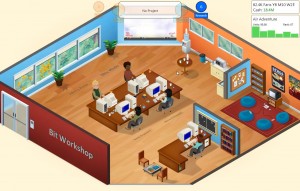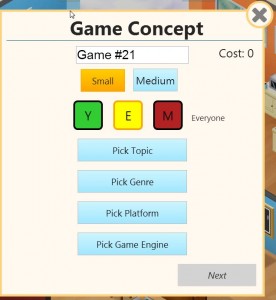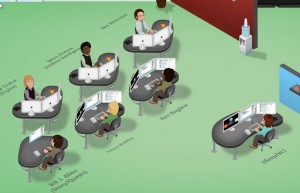Note (March 11, 2014): Sometime after release and after the above post was written, the game was patched and the advice offered here lost some of its effectiveness. It will still keep you from going bankrupt, and maybe it will help point you in the right direction.
Like most everyone else that reads technology websites, I saw the articles this week about how the two brothers that developed Game Dev Tycoon put up a torrent of their own game. In the torrented version of the game, the number of sales lost to piracy starts to increase until the in-game studio can’t turn a profit. As a marketing move, it was pure genius: every tech website and blog on the internet covered it. And it worked on this humble writer/gamer. So I spent the $8 and downloaded the game.
It’s wonderful.
WELL worth the $8. It’s not an easy game at first, but through some trial and error, and then reading the raw data values on the wiki, I’ve built myself a little cheatsheet to ensure that I’m making games with the maximum potential. If you want to make a Mature Virtual Pet Adventure for the Gameboy–err, Gameling–go right ahead. Just don’t expect it to make much money. If you want to play the game without the constant fear of bankruptcy, or if you’ve stalled out around the PlayStation (Playsystem) era, here are some tips!
One of the first things a player learns in-game is that some combinations of Genres and Topics are considered “Great combos” and they will sell well. There’s more to it than that combo, though. There’s also the target audience and the device itself.
I’ll use the Gameling as my example, because it’s where I have been able to make most of my early profits to propel my company from the garage into an office park. The Gameling favors young players. There’s a penalty assigned for the other categories. In fact, all the early consoles do this. Target your early games at the youth market, and you’ll do well. This starts to shift in the XBox 360 era, though PCs always favor Mature. Most of the combos I post below will target the highest modifier Genre for the given system. In the Gameling case it’s 1.01 for RPG and 1 for both Action and Casual. Before I dug into the numbers, I saw success with youth oriented RPGs. This explains why.
- Gameling: youth: RPG 1.01, Action 1, Casual 1
- TES/SuperTES: Youth: Action 1
- Playsystem: youth: RPG 1.07, Action 1.05
- PS2: youth: RPG 1.07, Casual 1.02, Action 1
- mBox: youth: Action 1.07, Adventure 1.015
- PC: Mature, any genre
- mBox360: Everyone: Casual 1.04, Action 1.015, RPG 1
- GS: Youth: Sim, strat, Cas 1.04, RPG 1.02
- PPS: Youth: 1.06 RPG, 1.03 Action
- PS3: Action 1, RPG 1
The downside to targeting the youth market is that they’re picky. There are a number of topics that non-starters and take a penalty. For any youth oriented game, avoid the following: Military, Dungeon, History, Horror, Business, Romance, Cyberpunk, Hospital, Vocabulary, Law, Game Dev, Startups, Hacking, Government, Prison, Surgery, Post Apoc, Alt Hist, Vampire, Werewolf, Aliens, Wild West, Dance
Games target to Everyone and Mature audiences only have one bad topic: Virtual Pet. Anything else is fair game as long as it the combination works with the chosen genre.
Here’s the quick and easy list of consoles and combos. I haven’t included every console since I’ve mostly focused on the ones with high market share. The wiki has a good list, but this is filtered by age level and console.
- G64: Any: Any combo below
- Gameling: Youth: RPG: Medieval, Fantasy, Sci-Fi, Mystery, Martial Arts, Spy, Detective, School, Fashion
- Gameling: Youth: Action: Sports, Medieval, Space, Fantasy, SciFi, Airplane, Martial Arts, Ninja, Spy, UFO, Time Travel, Hunting, Music, Rhythm, Superheroes
- Gameling: Youth: Casual: Sports, Racing, Airplane, Martial Arts, comedy, Movies, Fashion, Music, Rhythm
- TES/SuperTES: Youth: Action: See Gameling
- Playsystem: Youth: RPG: See Gameling
- Playsystem: Youth: Action: See TES
- Playsystem 2: Youth: RPG: See Gameling
- mBox: Youth Action: See Gameling
- GS: Youth Sim: Sport, Space, Racing, Sci-Fi, Airplane, Martial Arts, Transport, Movies, Evolution, Life, Virtual Pet, Hunting, City, School, Fashion, Music, Rhythm
- GS: youth: Strategy: Medieval, Space, fantasy, scifi, airplane, transport, UFO, evolution, city, school
- GS: youth: casual: See Gameling
- PPS: Youth: RPG: See Gameling
- mBox360: Casual: Sports, Racing, Airplane, Martial Arts, comedy, Movies, Vocabulary, Fashion, Music, Rhythm, Dance
- PS3: Action: Everyone: Sports, Military, Medieval, Space, Fantasy, SciFi, Airplane, Dungeon, Martial Arts, Horror, Ninja, Spy, Cyberpunk, UFO, Time Travel, Hunting, Prison, Music, Rhythm, Superheroes, Post Apoc, Alt Hist, Vampire, Werewolf, Aliens
- PS3: RPG: Everyone: Medieval, Fantasy, SciFi, Dungeon, Mystery, Martial Arts, Spy, Detective, Cyberpunk, School, Fashion, Post Apoc, Alt Hist, Vampire, Werewolf, Aliens, Wild West
Dual Combos
You gain the ability to research dual genres at some point in the basic office. I’ve done best when I held off on this until I had 6 developers and Large games. I’m not as clear on what makes a winning game here, but I’ve tried to focus on combos that are both design oriented or technology oriented.DUAL Combos:
- PS3 Dual: RPG/Adv: Detective, Fantasy, Medieval, Mystery, SciFi, School, Spy (Design Focus)
- mBox360 Dual: Casual/RPG: Fashion, Martial Arts (Design Focus)
- grPhone Dual: Sim/Strat: Youth: Airplane, City, Evolution, Scifi, school, space, transport
- grPad Dual: Sim/Strat: Youth: Airplane, City, Evolution, Scifi, school, space, transport
- mBox Next: RPG/Casual: Everyone: Fashion, Martial Arts
- PS4: RPG/Adv: Detective, Fantasy, Medieval, Mystery, SciFi, School, Spy
What are design and technology? Each genre rewards the player for focusing on either design oriented elements or tech oriented elements. I’ve outlined each genre and a general guide to slider levels for each of the development phases. When doing dual genres, I try to combine two genres with the same focuses.
The slider positions can adjust, but I’ve listed the minimum requirements. This refers to the chart at the bottom of the screen, not the actual sliders themselves. Once you start adding features to the game, you’ll have to adjust the ratios a little to ensure you get 100% functionality for each section. Don’t add features that require you to go outside the bounds listed.
The focus indicates that you want approximately 2/3 of your total points to be in that section. So if you’re making an RPG and you have 100 Design points, you should have around 50 Tech points. If you make an RPG that’s 100 Tech and 75 Design, prepare for bad reviews. As long as you follow the slider percentages, the overall focus should take care of itself unless all your features are in the wrong category.
Action Sliders (Tech Focus)
Phase 1: Engine (40% or more), Gameplay (40% or more), Story/Quests (no more than 40%)
Phase 2: Dialogues (no more than 40%), Level Design (40% or more), AI (40% or more)
Phase 3: World Design (20% or less), Graphic (40% or more), Sound (40% or more)
Adventure Sliders (Design Focus)
Phase 1: Engine (no more than 40%), Gameplay (any), Story/Quests (40% or more)
Phase 2: Dialogues (40% or more), Level Design (any), AI (no more than 40%)
Phase 3: World Design (40% or more), Graphic (40% or more), Sound (any)
RPG Sliders (Design Focus)
Phase 1: Engine (20% or less), Gameplay (40% or more), Story/Quests (40% or more)
Phase 2: Dialogues (40% or more), Level Design (40% or more), AI (20% or less)
Phase 3: World Design (40% or more), Graphic (40% or more), Sound (any)
Simulation Sliders (Tech Focus)
Phase 1: Engine (40% or more), Gameplay (40% or more), Story/Quests (any)
Phase 2: Dialogues (20% or less), Level Design (40% or more), AI (40% or more)
Phase 3: World Design (any), Graphic (40% or more), Sound (40% or more)
Strategy Sliders (Tech Focus)
Phase 1: Engine (40% or more), Gameplay (40% or more), Story/Quests (any)
Phase 2: Dialogues (20% or less), Level Design (40% or more), AI (40% or more)
Phase 3: World Design (any), Graphic (40% or more), Sound (40% or more)
Casual Sliders (Design Focus)
Phase 1: Engine (no more than 40%), Gameplay (40% or more), Story/Quests (no more than 40%)
Phase 2: Dialogues (no more than 40%), Level Design (40% or more), AI (no more than 40%)
Phase 3: World Design (20% or less), Graphic (40% or more), Sound (40% or more)
Tip: once you start building medium games, you can judge the exact percentages based on the workload percentages for the developers you assign to each category.
There are also specific features in the game. Things like graphics and sound and savegames. From what I’ve read and seen, they don’t specifically affect your rating. What they do is give you additional tech or design points. It’s these points have the largest effect on your games reviews. Put most of your features on the “40% or more” sections above. Generally speaking, you want the tech/design points to increase from game to game, or least every half dozen or so games. This can be done by researching more features or training your staff.
Staff become very important as you start tackling larger games. I found that I like to focus on Design oriented games, so I highly recommend having 3 very capable Design folks, 2 very capable Tech folks and 2 people that are good hybrids (one of which is probably your starting character). It’s also important to train your people. Once you start making decent money on games, and you should if you’re using the combos listed here, I’d do a round of training at least every other game. The goal is to get people that can specialize in things like Story/Quest, Dialogues, Graphics, World Design and Level Design (in more or less that order). For AAA games you want at least 3 but not necessarily more than 5 specialists on the game. Those specialists will make RPG/Casual games highly effective, and those have been my most consistent money makers.
The wiki has a solid training article, but the short version is this:
Design people should use Game Design for Pirates, G3 Pixel Cup and Game Design Course.
Tech people should use Code Incomplete, G3 Code Jam and Programming Course
Game Dev Gems and G3 Game Jam will train people about equally.
I’ve noticed a bug where the developer in the right-most chair stops upgrading at some point. I’m not 100% if it’s a bug or if that particular employee just stopped upgrading, but he also failed to grant benefits from research. Keep an eye on it if you give someone training but don’t see any improvement to their stats.
A few additional notes: Sequels sell well, but you want to wait at least a year to avoid a penalty (so make another game or two) and you get a bonus if you use a different engine. Don’t release the same genre/topic combo in a row. There’s a penalty. Trend bonuses are straightforward except for the “strange combo” trend. In that case, you actually want to release a game that has a badly fitting genre/topic. I’ve just spent this time doing research or training. We need standards here, people!
My absolute best (non-MMO) seller has been a Casual Martial Arts RPG. It moved nearly 9 million units and turned a profit of around 117 million dollars. It was only a large game, not AAA. I did make a Fantasy RPG Adventure MMO (AAA size) and it made me 430 million before I took it off the market.
I hope this information can make the game more fun for someone else. Good luck and enjoy. (And go buy it, you cheap bastards. It’s only $8.)



Hi, I just wanted to point out that if your developer stops upgrading, this is what should be done:
If your developer is more of a designer and stopped increasing in that, then improve his technology. And vice versa.
Hope this helped.
I Made A MMO kept it up for 10 years using the G3 convention made me 128 billion dollars Its insane right
Must be something wrong with my game. I only ever get 7s and 6s with perfect settings.
Hecate, I noticed that, too, a few months ago when I played this again for a while. It looks like the criteria for a hit game have changed since release. I’ve updated the post with a warning to this effect.
This game is probably one of my favourites, even though I’m only 6 1/2 Virtual years into the game. It’s probably one of the best tycoons out there, at least for me. One thing that I don’t really like about the game is that ratings have almost nothing to do with the game, and mainly just stay low because your completion of the game is low. I wish they would fix that.